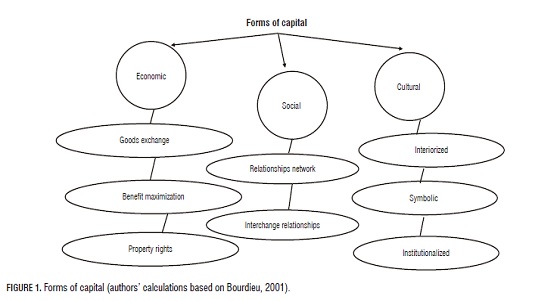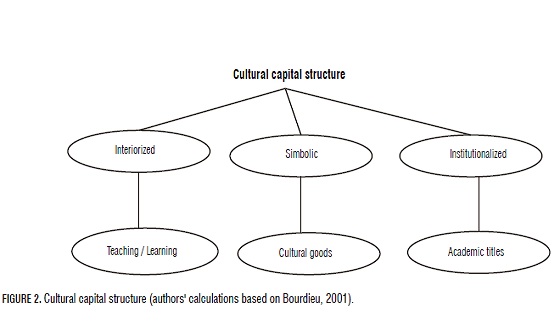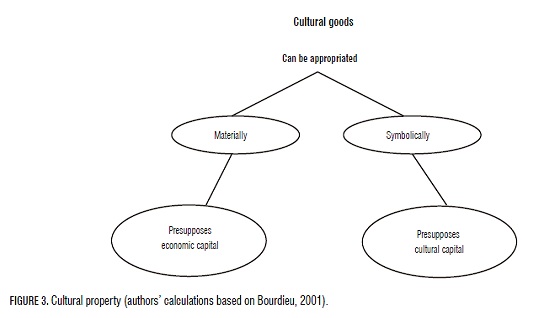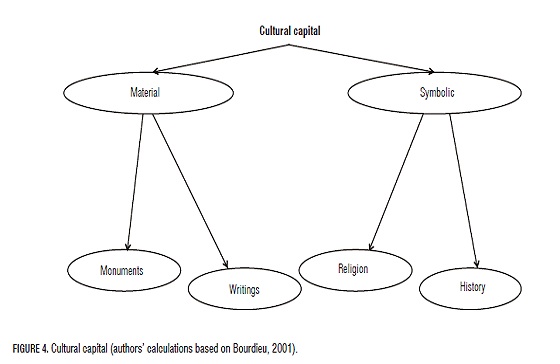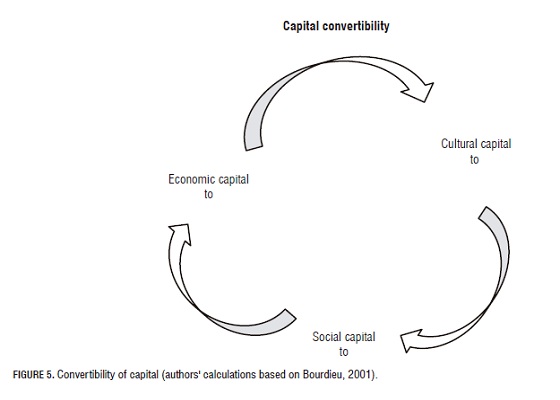Servicios Personalizados
Revista
Articulo
Indicadores
-
 Citado por SciELO
Citado por SciELO -
 Accesos
Accesos
Links relacionados
-
 Citado por Google
Citado por Google -
 Similares en
SciELO
Similares en
SciELO -
 Similares en Google
Similares en Google
Compartir
Agronomía Colombiana
versión impresa ISSN 0120-9965
Agron. colomb. v.29 n.1 Bogotá ene./abr. 2011
ECONOMY & RURAL DEVELOPMENT
Potentiality of symbolic capital in the rural space as generator of territorial development
Potencialidad del capital simbólico en el espacio rural como generador de desarrollo territorial
Alma Lorena del Cid1
1 Academic coordinator, Faculty of Economics and Business; researcher at Institute for Social and Economic Sciences, Universidad Rafael Landívar,Guatemala. email:alcid@url.edu.gt
Received for publication: 15 June, 2010. Accepted for publication: 2 February, 2011.
ABSTRACT
The article emphasizes the importance of cultural or symbolic capital together with social and economic capital, and its potential for the achievement of territorial development. Particular importance is given to the assignment of value to the distinct forms of objectified capital which different ethnic groups possess, as evidenced by the case of San Juan Comalapa, particularly with respect to the naif paintings elaborated there since over a century ago.
Key words: economic capital, social capital, cultural, identity and naif painting.
RESUMEN
El artículo expone la importancia del capital cultural o simbólico, en conjunto con el capital social y económico, y su potencial para lograr el desarrollo territorial. Se resalta la importancia de asignar valor a las distintas formas de capital objetivado que poseen distintos grupos étnicos, se ejemplifica el caso de San Juan Comalapa, en especial las pinturas naif que allí se elaboran desde hace casi un siglo.
Palabras clave: capital económico, capital social, capital cultural, identidad, pintura naif.
Introduction
The reflection takes the following pages is inspired by a territory located in the central region of Guatemala, the municipality of San Juan Comalapa, whose cultural richness is invaluable, since, until today, it retains much of its traditions and customs, characteristic Cakchiquel Maya indigenous group. This is explained in large part because, of the 35.441 inhabitants to the municipality, 97% are indigenous.
The theoretical basis of this document, as far as capital is concerned, is based on the concept presented by Pierre Bourdieu, considering that it makes a comprehensive analysis of the human capital that is capable of possessing, the enhancement makes Bourdieu the intangible but crucial to individual and social structures is crucial in this analysis.
In addition to the above, and relating to the development, has joined the regional development as the goal behind which can be approached in an organized and strategic expressions of symbolic capital that Latin American social groups have given their ancient cultures, but until the far have not provided an opportunity to break out of underdevelopment.
Make that leap in improving the living conditions that involves moving from underdevelopment to development, is what motivates a deeper study of the issues mentioned above.
In representations as naive painting, traditional sweets, handicrafts, textiles, among others, materialize is what Bourdieu calls symbolic capital, which is part of cultural capital. But combining and / or generates other types of capital, social capital and economic capital are explained throughout the document.
The forms of capital
According to Bourdieu: "Capital is accumulated labor in the form of matter, either as internalized or incorporated" (2001: 131). The distribution structure of different types and subtypes of capital, given at a certain point in time, corresponds to the inherent structure of the social world, ie., the totality of forces that are inherent, and by which it determines the durable operation of social reality, and decided the chances of success of the practices.
As currently used the term 'capital', resulting in a reduction of the universe of social relations to the simple exchange of goods exchange, which is objectively and subjectively oriented toward profit maximization and directed by personal interest or proper. The author indicates that in this way, economic theory implicitly defines all other forms of social exchange and economic relations are not disinterested.
Bourdieu notes that the capital may occur in three fundamental ways, as shown below in Fig. 1. The precise way in which it occurs will depend on what the appropriate scope, as well as the greater or lesser amount of processing costs, which are a precondition for effective appearance. The following describes each, although it will emphasize the cultural capital that is interested in highlighting and understanding for this reflection.
Economic capital
It is directly and immediately convertible into money, and is particularly suitable for institutionalization in the form of property rights. According to the author, in economic theory the concept of capital has been developed from an economic praxis, historical invention of capitalism.
The four major phases summarize the evolution of the capitalist mode of production (Amin, 1999):
1. How mercantilist assumed full acceptance of the logic of capital accumulation (economic).
2. The classical model, emerged from the industrial revolution, which from then defined the basic forms of capitalism in the peripheries remained rural, nonindustrialized, and their participation in the international division of labor is produced through agriculture and mineral production.
3. The post-war period: it was the industrialization of the periphery with enormous inequalities. There was a restructuring of national production systems as elements of a global integrated production system (globalization).
4. The most recent period, from 1990, as the author says, a period when the balance has collapsed global characteristic of the system, giving way to global disorder. The author attributes the chaos, among other factors that the system has been unable to develop new forms of social and political organization beyond the nation-state, a requirement of the globalized system of production and social and political relations able to reconcile the rise of industrialization in the new peripheral areas of Asia and Latin America with the objective of global growth.
The position of a country in the global hierarchy is defined by its ability to compete in the global market. But unlike other authors, Amin makes a very important signal "[…] competitiveness is a complex product that converge multiple economic, political and social". It is clear that he approaches his particular perspective of Bourdieu's approach in the sense that capital is not confined to economics.
The cultural or symbolic capital
Under certain conditions can become economic capital, and is suitable for institutionalization, mainly in the form of academic degrees. It can exist in three forms or states, as shown in Fig. 2.
1. Interiorized or incorporated, in the form of durable dispositions of the body. The accumulation of culture presupposes a process of internalization, which, while involving a period of teaching and learning takes time. At this point is determining the indication of the author: the incorporation of cultural capital can not be done by another, here is excluded from the principle of delegation. Because, who strives to acquire culture, work on himself, "is forming", which involves a personal cost to "pay with their own person".
The capital incorporated is a possession that has become an integral part of the person, in habitus. "[…] Having emerged 'being'. Built capital, having been internalized, it can not be transmitted instantaneously by gift, inheritance, sale or exchange (as opposed to money, property rights or titles of nobility)" (Bourdieu, 2001: 140). And as a corollary, the author notes that with the above, explains the difficulty of the use or exploitation of the cultural capital for the holders of economic or political capital.
2. Objectified has a number of properties that are determined in relation to the cultural capital incorporated or internalized. Cultural capital is transferable through its hardware in the form of cultural goods: paintings, books, dictionaries, tools or machines, which are the result and display of intellectual disputes, theories and their criticism (Fig. 3).
You can transfer legal ownership, the marketing of cultural goods, but it is important to note that the element that allows the true ownership is not necessarily transferable. For the true ownership, you need to have cultural capacities to understand and enjoy the cultural property acquired (Fig. 3).
Cultural property may be appropriate physically, for which economic capital is required, or symbolically, which presupposes cultural capital.
3. Institutionalized. A form of objectification which must be considered separately, because it confers entirely original properties of the cultural capital that should ensure, for example diplomas. For Bourdieu, the educational qualification is a certificate of cultural competence which confers on its holder a conventional value and lasting legally guaranteed. The title is a conversion of cultural capital, economic capital, which then become the appropriate economic capital and market the cultural capital accumulated.
The social conditions of the transmission and acquisition of cultural capital are less noticeable than the economic capital, so it is conceived as symbolic capital, ignoring the true nature of capital (Fig. 4). The author believes that the performance of educational action depends on the cultural capital previously invested by the family, and displays an undeniable fact: the social and economic performance of academic social capital depends, also inherited that can be mobilized to support it.
Social capital
It is a capital of obligations and social relations, is also convertible, under certain conditions, economic capital, and can be institutionalized in the form of peerages. Social capital consists of all the resources associated with potential or actual possession of a durable network of more or less institutionalized relationships of mutual acquaintance and recognition, means belonging to one or more groups.
based on social capital, material and symbolic aspects are inextricably linked, to the extent that can only be operated and maintained as this union is recognizable. Social capital has a multiplier effect on the capital actually available, the benefits of belonging to a group form the basis of solidarity that makes them possible, although these benefits are not consciously pursued.
The forms of capital described above, are configured differently in each territory, especially with regard to cultural capital. It is easily observable differences exist between countries, between cities and between groups within a municipality, which depend on multiple factors. In he case of countries like Guatemala, particularly the San Juan Comalapa, the historical fact of the Mayan culture, coupled with the Spanish influence, being in the modern (electronic communications, social networking, globalization) have created a series of capital that have led to modest progress in its development.
With regard to economic capital, is taking a turn, from agriculture as the main economic activity, to trade, which currently prevails in the area. Using an ocular count was determined that for the year 2009 in the town of the department head were 720 organizations, mostly trade, but there is also the presence of banking institutions, cooperatives, churches, among others.
With regard to social capital, to the internal networks are strong relationships, and very social initiative to form fields that allow them to better exploit the opportunities presented to them. Out of the municipality regarding opportunities diminish, and is part of what we have to work from a regional development plan.
As for cultural capital, despite being exposed to the influences of globalization, have managed to maintain their identity, and are interested in re-productive that identify these differences, to increase their economic capital. Besides this, several of its inhabitants have at least a college degree, and have more mid-level careers.
Family structures and other forms of socialization that exist in San Juan Comalapa enable the process of appropriating objectified cultural capital, since in that area families have a very strong cultural capital in the forms of socialization periods become simultaneously accumulation of symbolic capital.
For the real capital held by Comalapans persists as symbolic capital and economic capital to materialize, it is essential to an appropriation by them, and they translate into cultural production, which promoted an organized and strategic market and promote the development of the territory. This will open the door for an organized and strategic in a virtuous cycle, originated and maintained by the convertibility of the different types of capital (Fig. 5).
Territorial development
The current trend of territorial development, agrees a lot with Bourdieu's vision as to comprehensively consider human beings and human groups. This facilitates integrity, while more complex, the fact of understanding and to better promote its development. To tell Marchioni (1989) the territory is a physical and social entity, not just urban in coming to meet and sometimes to confront the contradictions, conflicts, social relations, institutions and population.
The territory is the first base of any cultural identity (CI). From it are made symbolic references and historical accounts that allow a group of people share the same traditions and cultural expressions" and "The rural territorial development concept is based on the confluence of all the players, the consensus of interests that benefit the community." (Ranaboldo and Schejtman, 2009: 9, 11).
To identify a rural community, Brenes (2007) identifies six classic features: life in the countryside, farming, livestock and fishing settlements scattered low density; own behaviors, strongly attached to the place, mainly economic logic tied to subsistence or survival; distinct culture of the people of the city, with a greater sense of solidarity and friendship.
Velarde, Garat and Marasas (2001) referring to the territorial dimension show that not only exists as a geographical space, if that space is occupied by people who share a number of factors: history, technical and production, cultic, economic, because the geographical itself, which defines ecological conditions of production, is energized by social and cultural aspects that define the area, and which form a key aspect to differentiate a product. The result of this translates into a multiplicity of actors with different interests, but responsible, voluntarily or involuntarily, the joint construction of the territory. The authors claim that the local construction of the territory is expressed in local identity. Among the factors that identify a group of people is the main language used, are also part of the identity of their crafts, food, festivals, art forms, landscapes, etc. These authors point out that the necessary political and administrative joints and economic articulation, add the articulation of cultural identity.
Identity
As is known, the identity traits are formed over time, from generation to generation, which does not necessarily mean that they are static. The behaviors and ways of doing things are changing under the influence of the environment.
In these times of globalization, the trend is to homogenize, the identity traits could be modified. But the opposite situation occurs due to the homogenization, when a territory is different from the rest, arouses curiosity in other cultures, and there is the interest of knowing what's so different. This represents an opportunity to objectify aspects of cultural capital which could become a form of economic capital.
We all have individual identities are determined by many aspects: gender, age, economic status, marital status, role in society, etc. But there are also collective identities, which are driven by various factors that determine individual identity and by new factors and/or common interests that generate collective identities.
Smith (1997), referring to the collective identity, including the category of space and territory: belonging to a locality or region generates cohesion among its inhabitants. He mentions that in the case of religion, seen as identity, integrated into various classes in a common interest, whose identity can encompass both small and large geographical areas. Religious identity is born of communication and socialization processes, which are based on cultural issues including: values, symbols, myths and traditions, among others. The author notes that there are similarities between religious and ethnic identities, are rooted in cultural criteria, strengthen each other, are able to mobilize and sustain strong communities.
Smith (1997) refers to the ethnic groups, as groups who share customs and traditions passed down from generation to generation, and who share certain standard of living. Weight that highlights the religious rites and customs in shaping a nation.
There are two approaches that attempt to explain the concept of ethnicity, one of which is the primary focus is supported by sociology in recent times. He believes that ethnic traits exist naturally, which is one of the qualities given of human existence. On the other hand, the approach, which considers that ethnicity is a matter of attitudes, perceptions and feelings, and can change according to situations.
Ethnic traits are modifiable and adaptable, this feature makes them very few groups that remain almost invariant over time in their habits, both aspects of daily life and in social attitudes, with the passage of time coexistence with other cultures, the exchange of goods in different shapes and other factors exert some influence there is communication between nations.
Smith (1997) points out some attributes of an ethnic community: an adjective, a myth (shared historical memory) of common origin, and elements of culture that make it different from other groups, association with a specific country, and solidarity toward certain significant sections of the population.
Dary (2003) in turn defines the ethnic group as one community where: largely biologically self-perpetuating, shares fundamental cultural values, integrates a field of communication and interaction, and includes members who identify themselves, and are identified by others, constituting a category distinguishable from other categories in the same order.
The same author states that define cultural content to an ethnic group: signs or overt signs, such as dress, language, the way home, lifestyle, and the orientations and values, moral standards and excellence. He adds that the cultural difference between two groups is a crucial fact of ethnicity and that only when cultural differences are perceived as important, and become socially relevant, then the social relationships have an element of ethnicity.
The territory in which this study focuses, meets several of the characteristics that define an ethnic group with a strong ethnic identity, whose vocation was primarily agricultural. This article mentions some forms of objectification of that identity or what would be the same symbolic capital: naif paintings, traditions and customs have been preserved as Kachiquel ethnicity, as well as customs and traditions arising from the fusion product the Spanish conquest, making the area a special place.
Despite this, Comalapa, like other people "have never been able to accumulate and store a considerable amount of surplus" (Lienbardt, 1994: 126) is also taking into account the remark made by Sachs (2007), in that another possible reason for the persistence of poverty is cultural in regard to discrimination against women.
Taking the above aspects, and giving value to the various capitals, it is considered that San Juan Comalapa has enormous potential to develop tourism as a strategy to generate regional development. This assertion is betting they do and Schejtman Ronaboldo (2009:10) in that "[…] the search for the exotic and the other encourages cultural reference in terms of recreation or enhancement of tangible and intangible cultural expressions". Meanwhile, it refers to a tourism boom linked to rural and natural areas, whose authenticity and value is the success of its development.
Some key aspects to be taken as a starting point when planning the design of a rural tourism strategy is to take into account the resources available to the state where they are and whether they should maintain, enhance or transform, take care identities subject to not affect the arrival of people from other cultures. It is important to assess the scope, capabilities and weaknesses of the population, since the intervention in an area could also lead to loss of identity rather than strengthen it.
As the author notes, "[…] cultural appreciation linked to territorial development processes is expressed in diverse, heterogeneous, with different actors that detect different and sometimes divergent interests". According Ampuero (2005) the participation of stakeholders is part of regional competitiveness, including:
• Social competitiveness: coordination at all levels.
• Environmental competitiveness: promoting an environment, making it distinctive.
• Economic competitiveness: achieving added value through sector-based interaction.
• Positioning in global context.
Within its territorial development perspective, the author states as a first determinant of productive transformation, which amounts to a new vision of rural, agricultural approach that overcomes or productivity alone. He points out that what is important, among other things, is to articulate and sustain competitive production of a particular territory, external dynamic markets, access to new technologies, upgrading the role of local actors and strengthening their capacities.
In the case of San Juan Comalapa, in addition to the exchange that can be done directly exporting their handicrafts, paintings, sweets, etc., To other markets, the goal is to attract the foreign market in that territory, that is, domestic tourists and foreigners, to know and value their culture and are willing to appropriate material and symbolic part of objectified cultural capital, especially in regard to the naive paintings.
A second element mentioned by Ampuero (2005), institutional development is the shared responsibility of institutions at local, intermediate and national levels, to facilitate interaction and cooperation between all actors, whether local or external, with broad participation in the process and its benefits.
It is based on the author's claim so as to external demand is the engine of change, the urban-rural interface, supports the development of agricultural and nonagricultural activities.
Naive painting as a form of objectification of symbolic capital
A unique activity in San Juan Comalapa, developed for about 100 years, is the naive painting; another important activity is the production of sweets that are supplied nationally, performing multiple rites, customs and practice of ancestral. This study focuses attention on the naive painting as a form of symbolic capital objectified, which concentrates multiple identities, and has become for the residents in structuring and structured structure. Naive painting is also known by other names, such as painting primitive, naïve art, naive paintings, folk paintings, folk art, and painting maya.
These works are self representations made by painters about various facets of daily life, both individually and in their community. In the paintings are realities that history being shaped, and typically occurs in different countries, each with his personal seal and representing different realities.
Mayor (1999: 10) states that "[…] among all this wealth of creative and imaginative life, oblivious to the problems that concern us in the cities, working on his canvas and wood, old and young, and boys and girls Indigenous artists, the same naive style, customs and landscapes that offer their works to friends and strangers"2.
In Comalapa has become a traditional practice of this art, while today there are approximately 2,000 painters, say the same artists. Several have had the opportunity to travel to different continents showing their works, have produced paintings whose destination is other countries have been visited by several personalities, including ambassadors from other countries.
Gabaldon (2006) relates directly to the economic sustainability of the development of a society's ability to continually increase their wealth, widely understood that only the material, but being aware that they must generate income to raise the standard of living of the inhabitants.
This type of art, like many other representations that are made in social groups, beyond the tangible work set out in the market, are evidence of an ancient culture that has been formed and become a way to externalization of feelings, beliefs, traditions, usually fragments of life that shape the identity of individuals.
As mentioned above, is considered to have great potential Comalapa appropriate and assign economic value to the various manifestations of objectified symbolic capital they possess. As stated in Tentori (1980), all human society, must have an economic organization that is regulated by a set of operational rules may be possible and cooperation between groups. In the present study, the proposal focuses on developing the territory with a focus on the tourism sector, as such, and as stated Ampuero (2005), in the case of rural tourism business, generating demand chain services, and this requires the participation of various actors in a region, rescue cultural values and knowledge that enable economic and employment alternatives, strengthening the link urban-rural market as a driving force.
Rural tourism promotes economic activity that requires entrepreneurs, finance and human resource skills. These activities may be related to cultural events, religious dates give a reference to a particular geographic area, among others, the World Tourism Organization(UNWTO, 1998) calls attractions, which must respond not only to meet needs of tourists, but also to meeting the needs of local community residents, and the preservation of the quality of the area's resources. It also generates what Brugger et al. (1994) calls social value added, which is achieved when small business success means economic growth for many people, also become training centers and the promotion of equal opportunities between men and women.
The challenge in the short and medium term is to make diagnoses that establish the current status of various capital that San Juan Comalapa, assess their real potential based on the diagnosis, develop a proposal to guide the productive transformation of the territory, establish limits that protect their identity and their cultural capital in general, social, economic and environmental. Setting the capacity of the territory which prevents the UNWTO (1999) is feared to bring the excessive commercialization of cultural traditions that can distort the cultural heritage of the territory. All this is part of the preparation of a strategy of territorial development.
A crucial issue at present in all industries, including tourism is globalization and its implications, which are not necessarily negative, for example,
Hypothesis
The territory of San Juan Comalapa and ethnic identity has objectified symbolic capital, which together with the valuation of other resources, could lead to a change in production based on the development of a strategy of ecological and cultural tourism.
__________
2 Federico Mayor Zaragoza, director general of UNESCO when preparing the study Naive Art in Guatemala.
Literature cited
Amin, S. 1999. El capitalismo en la era de la globalización. Ediciones Paidós Ibérica, Barcelona(Spain). [ Links ]
Ampuero, A. 2005. Insumos esenciales para el estado del arte y el mapa regional. Proyecto de desarrollo territorial rural a partir de servicios y productos con identidad. In: Territorios con identidad cultural, http://www.rimisp.org consulted: March, 2010. [ Links ]
Bourdieu, P. 2001. Poder, derecho y clases sociales. 2nd. ed. Editorial Desclée de Brourwer, Bilbao (Spain). [ Links ]
Brenes, C. 2007. Comunidades rurales. Criterios y herramientas para su diagnóstico. 1st. ed. EUNED, San José (Costa Rica). [ Links ]
Brugger, E., J. Nelson, and L. Timberlake. 1994. Forjadores de porvenir: la pequeña empresa y el desarrollo. McGraw Gill Interamericana, Santiago de Chile. [ Links ]
Dary, C. 2003. Identidades étnicas y tierras comunales en Jalapa. Serviprensa, Guatemala. [ Links ]
Gabaldon, A. 2006. Desarrollo sustentable: la salida de América Latina. Random House Mondadori, México D.F. [ Links ]
Lienbardt, G. 1994. Antropología social. 2a ed. (5a reimp.). Fondo de Cultura Económica. México, D.F. [ Links ]
Marchioni, M. 1989. Planificación social y organización de la comunidad. 4a ed. Editorial Popular, Madrid. [ Links ]
UN-WTO. 1998. Introducción al turismo. 1a; ed. Organización Mundial del Turismo, España. [ Links ]
UN-WTO. 1999. Guía para administraciones locales: desarrollo turístico sostenible. Organización Mundial del Turismo, España. [ Links ]
Ranaboldo, C. and A. Schejtman. 2009. El valor del patrimonio cultural. 1a ed. RIMISP í IER, Lima (Perú). [ Links ]
Sachs, J. 2007. El fin de la pobreza: como conseguirlo en nuestro tiempo. 2a ed. Debate, Buenos Aires. [ Links ]
Smith, A. 1997. La identidad nacional. Editorial Trama, Madrid. [ Links ]
Tentori, T. 1981. Antropología cultural. Editorial Heder, S.A., España. [ Links ]
Mayor, F. (1999). Arte naif en Guatemala. Unesco-Bancafe. Ciudad de Guatemala. [ Links ]
Velarde, I., J. Gárat, and M. Marasas. 2001. Promoción de producciones típicas: un enfoque territorial con productores familiares de la región rioplatense, Argentina. Agroalimentaria 12. [ Links ]













